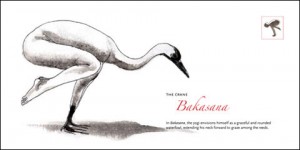On this first day of spring, my body has some kind of internal switch that just goes click and just like that, the Winter of My Discontent begins to fade. Suddenly my brain feels awake. My body wants to move and stretch and bounce. Even if the spring sun isn’t quite warm, it’s the promise of longer warmer days ahead that brews excitement. In the past two months I’ve completed a kitchen renovation and began the fulfillment of a lifelong dream—the opening of my private psychotherapy practice. Seems only moments ago, I was the young adult on the other side of the chair (mat?) seeking identity, serenity. My new office is bright, charming, and cozy…and there’s a bamboo plant outside the window. In New England? How strange. It must be a sign. And, most importantly, the office is just big enough for two yoga mats. One for me. One for my client. Nevermind the 20 degree slanting hardwood floor. In New England we call that charm. I wonder how I could make that slope work to my advantage? Would it help me take flight in a handstand, or topple me over more easily?
I’ve yet to bring yoga into my private psychotherapy practice, but I’ve proudly heralded it as a specialty on my publicity material. I’m hoping to have a brave client one day. I’ve continued to use it with my teenaged clients at my “day job” and now I’m up to three clients with whom I’ve done regular practice. I recently began with a teenaged client whose body had bore the brunt of unspeakable abuses, and as a result she experiences physical pain in the parts that had been attacked and injured in the past. Like ghosts that continued to haunt her physical being, she feels sore and tense. Her individual therapist tells me that she has begun to teach her young client some simple breathing and relaxation exercises to precede their talk therapy. This young lady is sharp as a tack, and insightful beyond adult years, but words are sometimes hard to access when approaching the painful subject of her trauma. English is not her first language, and moreover, she is battling the tranquilizing effects of trauma on the brain. Surviving moments of life-threatening fear changes something in the brain—the mind learns to remain groggy and hibernated in order to feel safe, even long after the threat of harm is gone.
She had previously taken a group yoga class, and her preconceptions of yoga were that she “didn’t like it”. I wondered if the class had moved too quickly, ignored the sensitivities of a traumatized body…I was intent on showing her that a tailored, trauma-sensitive practice could be something entirely different. A primary area of focus was her back and shoulders. She had suffered severe injuries in these areas at the hands of her abusers, and although her body had medically healed, she still carries the emotional scars of this trauma through pain and tension in these areas.
There are three of us in the room—client, therapist, me. I lead her through slow yogic breathing, child’s pose, cat/cow, downward dog, gentle half spinal twists, thread the needle, shoulder openers including standing yoga mudra with legs apart…This is all done through multiple layers of body and language translation. The teaching begins with my own body, which translates into yoga language inside my brain. Yoga language into English from my mouth. English into the Portuguese-speaking brain of her therapist. Portuguese into Spanish from her mouth, Spanish into the brain of the client. The brain of the client into the body of the client. She moves her body accordingly. Throughout the practice, I allow her to come out of postures in her own time, giving her a sense of choice, control, and attention to her own body—three things she had been sorely robbed of in her past.
It is a short practice (never enough time!). After we are done, I roll up my mat and leave. Later I ask her therapist how she liked the practice. She tells me that after I left, she talked for an hour straight. Suddenly, before where there were few words, she had something to say. Something woke up.
